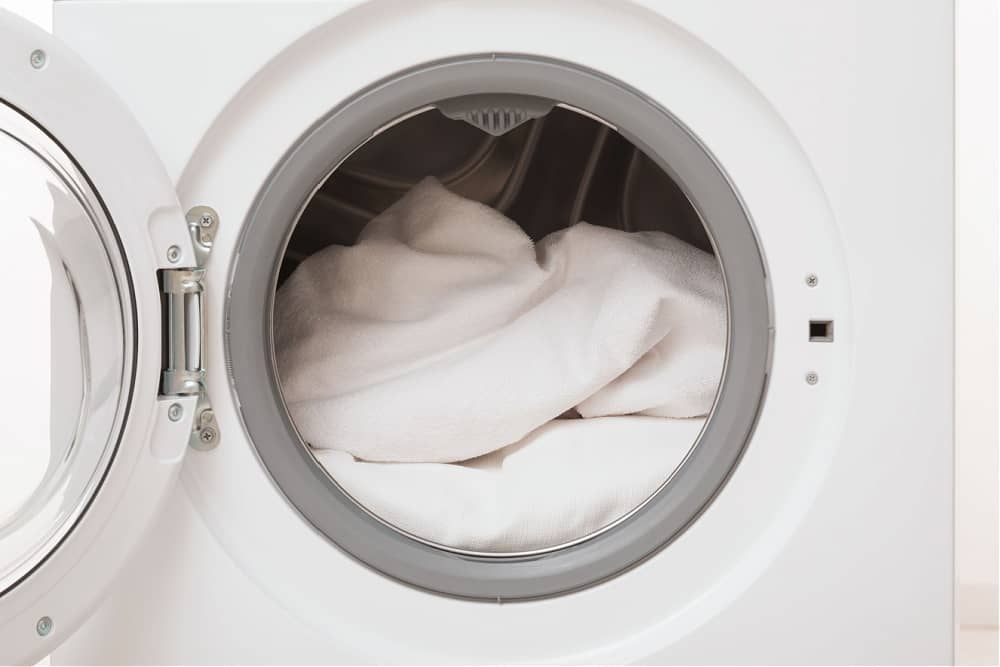After a long day, nothing beats slipping into a bed with freshly washed sheets.
But clean bedding isn’t just about comfort. Dirty bed sheets trap allergens and bacteria, which can affect your health.
Whether you prefer bamboo, cotton, linen, or silk bed sheets, each fabric needs proper care.
This guide will teach you how to wash bed sheets correctly, no matter the material!
Bamboo | Cotton | Flannelette | Linen | Satin | Whitening Sheets
Different Types of Bed Sheets
There are several types of bed sheets, each with its own texture and benefits.
BAMBOO: Bamboo bed sheets have a silk-like texture. They’re highly breathable and moisture-wicking, making them great for warm weather.
COTTON: Cotton bed sheets are suitable for everyday use as they’re durable and easy to care for. Various types like Egyptian and Pima offer different levels of softness.
FLANNELETTE: Flannelette sheets are made from brushed cotton. They’re cosy and warm — perfect for colder weather as they provide excellent insulation.
LINEN: Linen sheets have a crisp, textured feel that softens with every wash. They are highly breathable and strong, though prone to wrinkling.
SATIN: Satin sheets have a smooth, glossy finish and are usually made from a blend of silk and synthetic fibres like polyester.
SILK: Silk sheets are exceptionally soft. They regulate temperature naturally and are gentle on the hair and skin, though they require gentle care.
How Often to Wash Bed Sheets
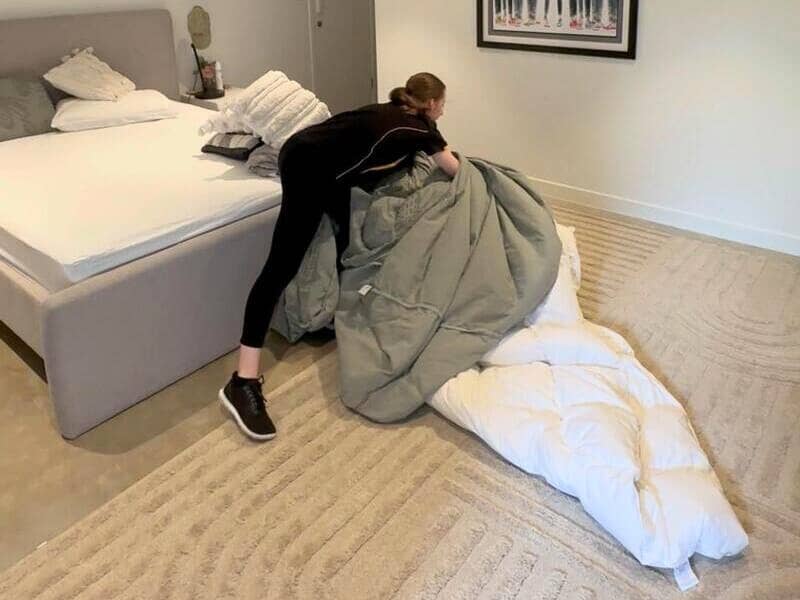
So, how often should you wash your sheets? The universal advice is to wash sheets weekly.
This applies to fitted and flat sheets, as well as pillowcases.
However, you should wash sheets right away if they get stained or if you’ve been ill.
While this seems too frequent, it makes perfect sense.
We spend hours in bed every day — about a third of our lives — so sheets collect a lot of sweat, body oils, and dead skin cells.
This build-up attracts bacteria and dust mites, which can trigger allergies.
If your chores feel overwhelming, professional cleaners can help. They can tidy your home and run a laundry load or two!
Do You Have to Wash New Sheets?
Yes, always wash new bed sheets before using them!
Manufacturers usually treat bed sheets with chemicals like formaldehyde and starches to achieve a wrinkle-free, crisp look.
However, these can irritate your skin or make the fabric feel stiff.
A pre-wash removes irritants and residue, leaving your new sheets softer and safer to sleep on.
Before Washing Your Bed Sheets
Before washing your bed sheets, check the care label for specific washing instructions.
You should also pre-treat stains so they don’t set in the washer or dryer.
Then, wash your sheets separately to avoid colour transfers and tangling.
It also ensures you’re not overloading your washing machine. Your sheets need ample room to circulate for a thorough clean.
If your washer has an agitator, place each sheet in a large mesh laundry bag to prevent damage.
Pre-Treating Stains on Bed Sheets
Fresh stains are easier to remove, so act fast! Strip the stained sheet off the bed immediately to avoid spreading the mess to other bedding.
When getting stains out of bed sheets, use a compatible stain remover. Check the product label and do a spot test first.
To test the stain remover, dip a cotton swab in the solution, then dab it on a hidden spot in your bed sheet. Wait about 10-15 minutes.
If the colour fades or transfers, do not use that product. But if there are no issues, go ahead and treat the stain.
Once the stain is gone, wash your sheets as usual.
Remember: never put stained bed sheets in the dryer. Heat can set the stain and make it harder to remove.
Blood stains
A 3% hydrogen peroxide solution can effectively get blood stains out of bed sheets.
First, turn the fabric inside out. Rinse the stained area under cold running water to flush out as much blood as possible. Do not use hot water as it can set the stain.
Soak the stained area in cold water for 10–15 minutes, then spray hydrogen peroxide directly onto the stain.
You’ll likely see it fizzing, a sign that it’s breaking down the blood. Let it sit for 10–15 minutes, then rinse with cold water.
For delicate sheets, try gentler methods like a saltwater soak or an enzyme-based cleaner.
Food and drink stains
Use a thick baking soda paste for food and drink stains on bed sheets.
To start, remove any solid food bits from the sheet. Then hold the fabric under running water, letting it flow through the back to push the stain out.
Apply a baking soda paste onto the stain and let it sit for 15–30 minutes.
Gently scrub the fabric against itself or with a soft cloth. Afterwards, rinse with cold water.
For delicate bed sheets, try an enzyme-based cleaner instead.
Makeup stains
Remove makeup stains from bed sheets with micellar water makeup remover or dish soap.
Brush off any loose makeup bits from your bed sheet, but be careful not to spread the stain.
For powder makeup like blush or eyeshadow, dab the stain with a cotton ball dipped in micellar water. Keep dabbing until the stain lifts.
For oil-based makeup like foundation, lipstick, or mascara, apply a bit of dish soap to the stain. Lightly rub the stain to work the soap in.
Wait 15–30 minutes, then rinse with cold water.
For stubborn makeup stains on bed sheets, try diluted oxygen bleach (1 tbsp oxygen bleach in 1L water).
On delicate bed sheets, use baby shampoo or mild detergent instead.
Sweat stains
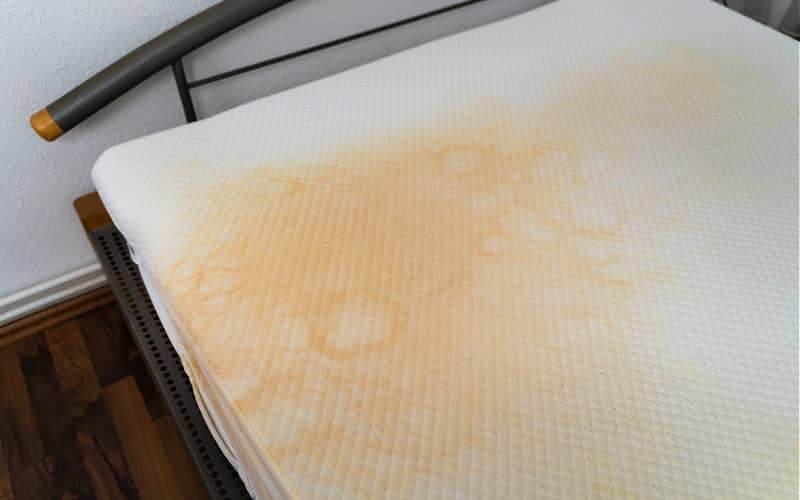
For sweat stains on bed sheets, try diluted oxygen bleach. It’s safe for most fabrics, but avoid using it on satin and silk.
Add ½ to 1 tbsp of oxygen bleach per litre of lukewarm water (up to 40°C). Soak the stained area in this solution for 15–30 minutes.
For tough stains, soak longer and check periodically to make sure the fabric isn’t being damaged. Make sure the stain is gone before washing the bed sheets.
For delicate sheets, use a white vinegar spray (2 tbsp white vinegar + 2 cups of water).
Urine stains
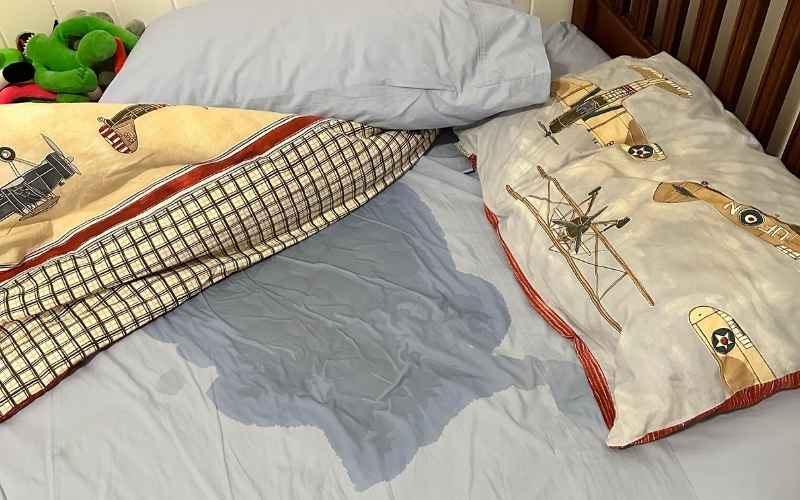
Use an enzyme-based cleaner to remove urine stains on bed sheets.
To start, press paper towels or a clean cloth firmly onto the bed sheet. This helps absorb the excess liquid.
Next, apply an enzyme-based cleaner, following the label instructions.
To remove any lingering urine smell on the bed sheet, add 1 cup of white vinegar to the rinse cycle.
How to Wash All Types of Bed Sheets
What setting to wash bed sheets depends on the fabric. Generally, cool water (lower than 30°C) and mild, low-suds detergent will preserve your sheets’ quality.
Most bed sheets can be machine-washed on a gentle cycle. But for satin and silk, hand washing is ideal.
Afterwards, line-dry in the shade to avoid fading and wrinkling.
Skip dryer sheets, fabric softeners, and harsh cleaners like chlorine bleach. These can damage and leave residue on your bed sheets.
Do not use high-heat settings in the washer and dryer to prevent shrinking.
How to wash bamboo bed sheets
Detergent: Mild
Water temp: Cool (Lower than 30°C)
Wash cycle: Gentle
Drying: Air-dry in the shade
Wash bamboo sheets on a gentle cycle with cool water.
Bamboo fabrics have a delicate, silk-like texture, so a mild detergent is suitable. You can also look for one that’s formulated for natural fibres.
After washing, hang bamboo sheets in a shaded area.
For faster drying, use the lowest heat setting on your dryer and run a 10-minute cycle. Remove the bed sheets while they’re still damp and let them air-dry.
How to wash cotton bed sheets
Detergent: Regular
Water temp: Warm (30°C–40°C)
Wash cycle: Regular
Drying: Tumble dry on low or medium heat
Cotton bed sheets are generally more forgiving than other fabrics. You can toss them in a normal wash cycle with warm water.
Most laundry detergents are suitable for cotton sheets. If you have sensitive skin, opt for a mild detergent.
Tumble dry cotton bed sheets on medium heat, and take them out promptly to minimise wrinkles.
For Egyptian, Pima, or high thread count (400+) cotton sheets, use cold water and a mild detergent. Dry on a low-heat setting or on a clothesline.
How to wash flannelette bed sheets
Detergent: Mild
Water temp: Cool (Lower than 30°C)
Wash cycle: Gentle
Drying: Air-dry in the shade
Flannelette bed sheets have a brushed cotton surface with tiny, raised fibres. It’s extra cosy but prone to pilling — fibres clumping into small balls after a wash.
To minimise wear and tear, wash flannelette bed sheets on a gentle cycle with a mild detergent and cold water. Then, hang the sheets in a shaded area to dry.
If you must use a dryer, choose the lowest heat setting and spin for 10 minutes. Check if the sheets are still damp, then let them air-dry.
How to wash linen bed sheets
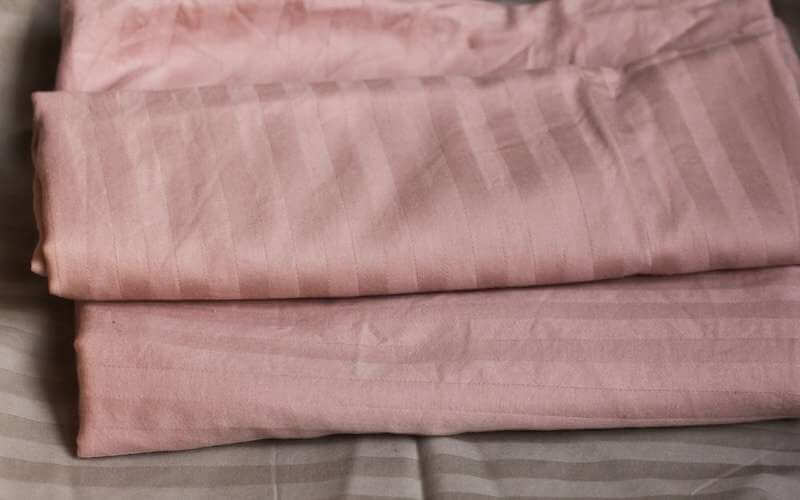
Detergent: Mild
Water temp: Warm (30°C–40°C)
Wash cycle: Gentle
Drying: Air-dry in the shade
Linen is a durable natural fibre. It can withstand frequent washes and becomes softer over time.
Wash linen sheets on a gentle cycle using warm water. Use a mild detergent, preferably one made for natural fabrics.
Keep in mind that linen is prone to wrinkling, so line drying out of direct sunlight is best.
If using a dryer, choose the lowest heat setting. Remove the bed sheets after 10 minutes while they’re still damp, then air-dry.
How to wash satin or silk bed sheets
Detergent: Mild
Water temp: Cool (Lower than 30°C)
Washing: Hand wash
Drying: Air-dry in the shade
Hand washing is best for satin and silk sheets.
Silk is a natural fibre known for its fine, smooth texture, but it’s also very delicate.
Meanwhile, satin is usually made from a mix of silk and synthetic fibres, like polyester or rayon.
To start, fill a large basin with cool water. Add just 1–2 tbsp of mild laundry detergent so it’s easy to rinse.
Soak for 10–15 minutes. Gently swish the fabric around, then rub softly with your hands to lift dirt. Do not scrub, twist, or wring the sheets vigorously.
To rinse, drain the basin and refill with cool water. Repeat until the water runs clear.
Next, roll each sheet in a dry towel and press lightly to squeeze out excess moisture. Afterwards, air-dry in a shaded area.
Some satin and silk bed sheets are machine-washable on a gentle cycle. Check the care label to be sure. If allowed, place each sheet in a mesh laundry bag first.
Never put these sheets in a dryer to avoid heat damage.
How to Whiten Bed Sheets
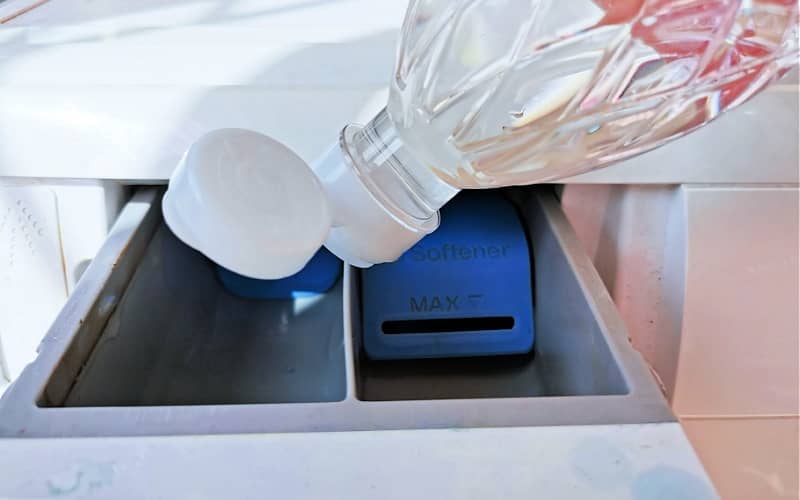
Always wash white sheets separately. If that’s not an option, only pair them with other white items to avoid colour transfer.
To whiten bed sheets, add half a cup of baking soda to the wash cycle. Baking soda can neutralise odours and boost a detergent’s cleaning power.
However, avoid using it on satin and silk because it can dull the sheen and weaken the fibres over time.
For delicate sheets, add half a cup of white vinegar to the last rinse. Aside from brightening fabrics, vinegar also helps remove detergent residue.
After washing, dry cotton bed sheets out in the sun for mild, natural bleaching.
Meanwhile, delicate bed sheets should be air-dried in the shade first. Then, put them out under direct sunlight for just 10–15 minutes.
Too much heat can cause these sheets to shrink.
Bed Sheet Care and Maintenance
For everyday use, choose durable, easy-care sheets like cotton and linen. Rotate between sets to extend their lifespan.
Keep your sheets fresh with good hygiene. Shower before bed and wear clean sleepwear to reduce body oils and sweat on your sheets.
Check your cosmetic and skincare products, too. Some lotions can leave residue and fake tan can transfer to sheets.
Proper storage also matters. After washing, fold bed sheets neatly and store them in a cool, dry place.
Lastly, don’t forget the rest of your bedding, which includes:
Regularly clean all your bedding to prevent dirt from getting onto your sheets.
FAQs: More About Washing Bed Sheets
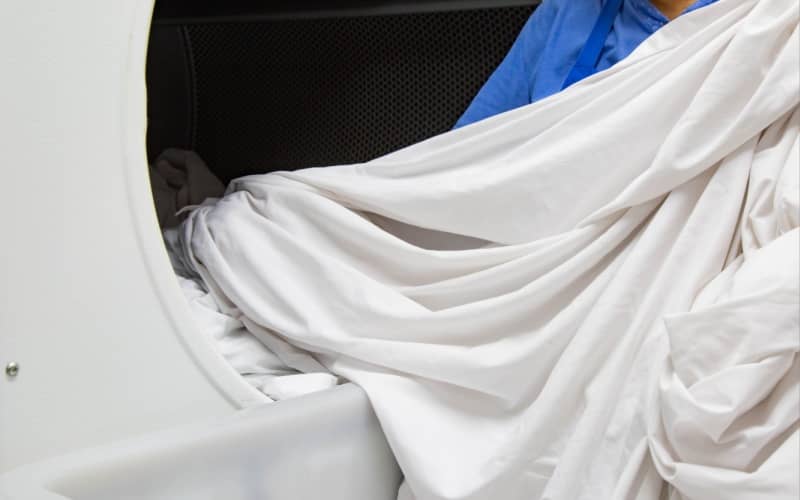
Learn more about washing sheets the right way!
Can you wash sheets and towels together?
Ideally, you should not wash sheets and towels together. Towels are thicker, while bed sheets are usually more delicate.
The friction between them in the wash can cause sheets to pill. Towels can also shed plenty of lint, which may stick to sheets.
If you must wash them together, make sure your washer is big enough for several bulky items. Then follow these tips to prevent damage:
- Wash similar colours together
- Place each item in a mesh laundry bag
- Use cold water and run a gentle wash cycle
- Use a mild detergent and avoid harsh cleaners
Is it okay to wash bedding at 40 degrees?
Washing at 40°C is generally safe for cotton and linen sheets. It also works for synthetic blends, like those with nylon, rayon, or polyester.
More delicate fabrics are best washed in cool water. Always check the care label for specific washing instructions!
How to sanitise bed sheets?
To kill bacteria, bed bugs, and dust mites, wash cotton sheets in hot water (up to 60°C).
However, delicate bed sheets like bamboo, flannelette, and linen can be damaged by high heat. Use cool water and oxygen bleach for these types.
Consult the product label for compatibility, and follow the dilution instructions.
For satin and silk bed sheets, a professional laundry service is the safest option for a deep clean.
Are bed sheets delicates?
It depends on the fabric. Satin and silk bed sheets are often considered delicate.
Meanwhile, cotton and synthetic blend sheets are more durable. They can usually handle regular washing without special treatment.
Refer to the care label to be sure!

